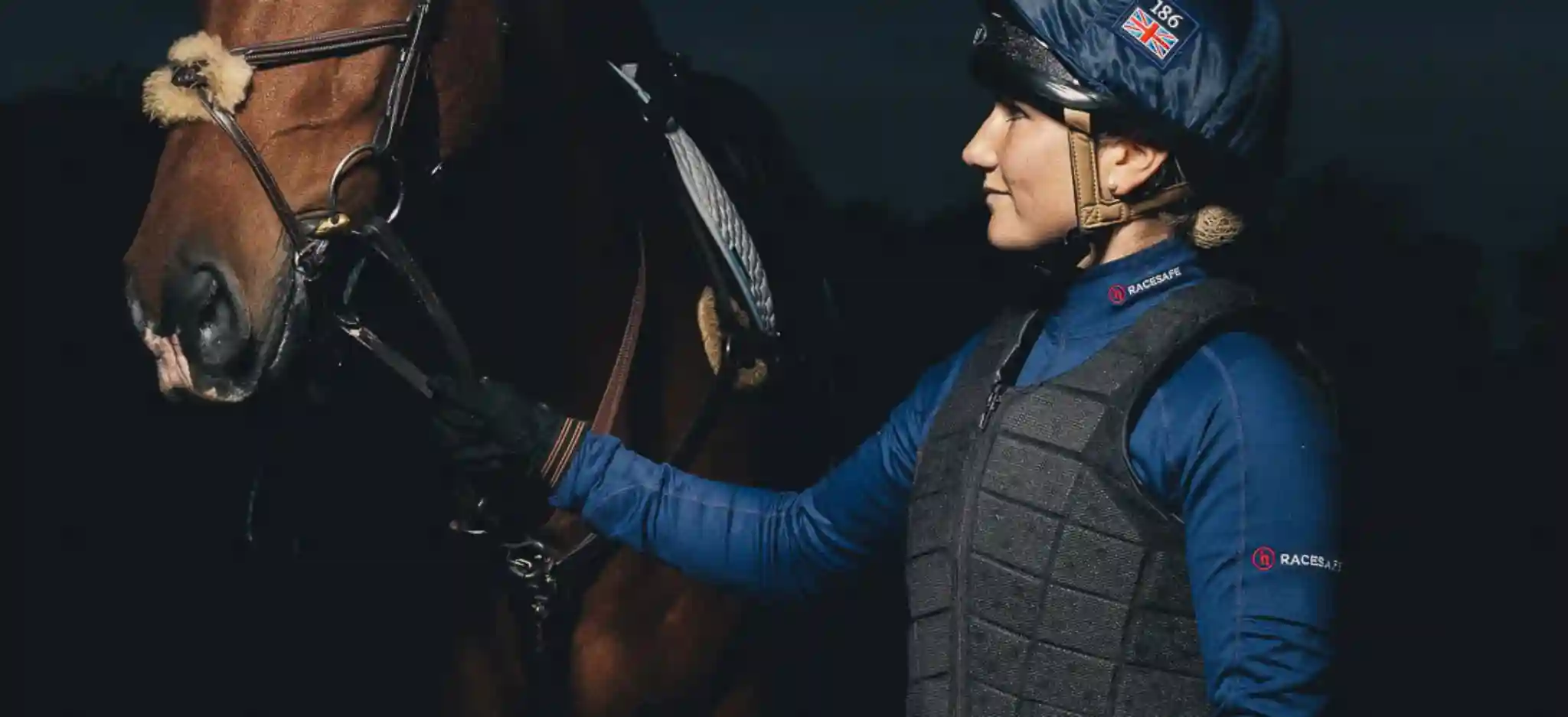Body Protectors
Whether you’re about to back a young horse, go eventing or for a hacking, consideration should always be given to body protection.
Body protectors are designed to absorb impact from a fall or kick from a horse.
Although body protectors are compulsory for some competitions, an increasing number of riders report feeling more confident when wearing one in everyday situations from hacking to schooling over fences.
Another reason many more riders are opting to wear body protections on a daily basis is that they have been designed to be more flexible, lightweight and quick to put on.
Levels of Protection
BETA originally brought together riding organisations, doctors, riders, manufacturers and retailers to develop the now widely recognised BETA Body Protector Standard.
The BETA 2009 and 2018 Body Protector Standard meets all the requirements of the respective European standard (EN 13158). A revised edition of the BETA standard was published and adopted by BETA in 2018 as the new BETA standard, but will run alongside the 2009 version for at least the next 5 years whilst the older stock works through the market.
The BETA Standard sets criteria for shock-absorption, controls the area of the body that must be covered and ensures there are minimal gaps between the protective foam panels. It encompasses three levels, each designed for different activities and denoted by a colour-coded label on the garment.
- Level 1 – provides the lowest level of protection that is only considered appropriate for licensed jockeys. Level 1 is designed to meet the weight restrictions that apply to professional jockeys whilst racing.
- Level 2 – offers a lower than normal level of protection. It is considered suitable for general riding in very low risk situations and for professionals such as licensed jockeys when specified by their racing authority or regulatory body.
- Level 3 – is considered appropriate for general riding, competitions including eventing and working with horses. Level 3 body protectors should prevent minor bruising that would have produced stiffness and pain, reduce soft tissue injuries and prevent a limited number of rib fractures.
There is a separate BETA Standard for shoulder protectors. Research into falls onto the shoulder during eventing competitions revealed that wearing shoulder protection reduces the risk of breaking your collarbone by up to 80%.
Body Protector Fitting at Wadswick
Wadswick are a BETA trained retailers to fit body protectors and can offer riders free, personalised fittings and advice.
We stock a large range of size in Airowear, Champion, Equi-sential, Racesafe, Rodney Powell and Waldhausen body protectors for both Adults and Children.
Frequently Asked Questions
Body protectors are designed to offer protection to a rider when falling off, being kicked or trodden on by a horse.
No body protector can prevent serious injury in every situation, but they can increase the chances of staying alive and reduce the severity of injuries.
When not in use, body protectors should be hung on a clothes hanger. Doing up zips ensures they keep their shape, while closing Velcro fastenings will help prevent them becoming clogged with horse hair and hay particles.
Most body protectors are made from heat sensitive PVC nitrile foam, which is why they feel increasingly comfortable as they soften and mould to the wearer’s body. So try storing your protector in a warm (but not artificially hot) environment to ensure it’s nice and flexible for that early morning ride.
Body protectors should be replaced at least every three to five years, after which the impact absorption properties of the foam may have started to decline.
If you should have a heavy fall, your body protector should be checked immediately for dents. The foam will expand back to its original shape within 30 minutes; but if a dent is showing on examination, then it’s likely that this part of the garment has lost its impact absorption properties and should be replaced.
Hidden damage that a body protector may have sustained is also a good reason for avoiding second-hand garments or those with unknown histories.
Taking good care of your body protector means that it will last longer within the three to five year recommended lifespan. So don’t leave it lying around at the yard or in the lorry to be chewed and trodden on. Spending too much time in a hot car or damp tackroom won’t do it any good either.
The most up-to-date body protector standard is the BETA 2009 or 2018 Standard.
Body Protectors bearing the now obsolete Level 5 or 7, Class 1, 2 or 3 labels and BETA 2000 Level 1, 2 or 3 will no longer be effective and should be replaced.
Most body protectors are designed to comply with EN13158 and a recognised BETA level standard. Riders looking for the best protection should choose level three, which will meet the requirements for any equestrian discipline.
Level 3 body protectors have the highest level of protection that BETA recognizes.
At this level body protectors should prevent minor bruising and reduce soft tissue injuries as well as prevent a reduced number of rib fractures.
Level 3 body protectors are appropriate to use for cross country competitions and other general riding purposes.
A new body protector will mould to your body as you wear it, however Airowear have suggested 7 key things to check before riding:
- Snug fit on the waist with more room on the chest
- Able to take a deep breath in without feeling restricted
- Fully covers your rib cage but not your belly button, which is the bend point on your body
- To test that your body protector is the correct length, try bending forward at the waist. If your body protector digs into your stomach uncomfortably, it is likely too long
- Adjust your shoulder straps so that they lay midway between the point of the shoulder and the base of the neck
- There should be around three inches between the bottom of the back of the body protector and the cantle of your saddle. If the body protector is longer, it may interfere with the saddle
- Check that each strap covers the orange marker on the velcro. If you can still see any part of an orange section when your body protector is adjusted correctly, the body protector is too small.
How to fit and wear a body protector
Once you’ve chosen your body protector size, here are 6 steps from Airowear to ensure it fits you correctly:
Step 1 – Fit your body protector over light clothing, with heavier garments worn over the top.
Step 2 – Before trying on, loosen the chest and waist straps of the body protector.
Step 3 – Once on, insert thumbs into the armholes to bring the two panels together to make it easier to zip the body protector.
Step 4 – Fasten the adjustable straps so that a snug but comfortable fit is achieved. Ensure the contrast orange velcro markers are covered.
This step will determine whether a smaller or larger size is required. If the orange cannot be completely covered, the body protector is too small. If the velcro fastenings cannot be closed enough to ensure a snug fit, the body protector is too large.
Step 5 – Adjust the shoulders so the neckline lies flat against the body. If this cannot be achieved, a shorter back length may be needed.
Step 6 – If possible, check the back length by sitting on a saddle and ensuring there is approximately a hand’s width between the saddle and base of the body protector.
If you are local and need a free body proctor fitting please come in and speak to a member of staff.
https://www.youtube.com/watch?v=LS6fVcMB6Jo&t=1s
It’s not very often you see a show jumper wearing a body protector even though Showjumping is a dangerous sport.
Normally show jumpers wear body protectors if they are protecting an old or healing injury.
Unlike the Cross country phases of eventing, body protectors are not compulsory in show jumping competitions.
Airowear have created a next-generation back protection mainly aimed at show jumpers.
Hidden from the outside world, the back protector has been designed by Airowear for riders not wearing a full body protector and who prefer a lighter alternative.
Not intended for cross-country riding. This product only protects the back and does not offer protection to ribs or against severe torsion, flexion, or extension or crushing of the body. More information can be found here.



















